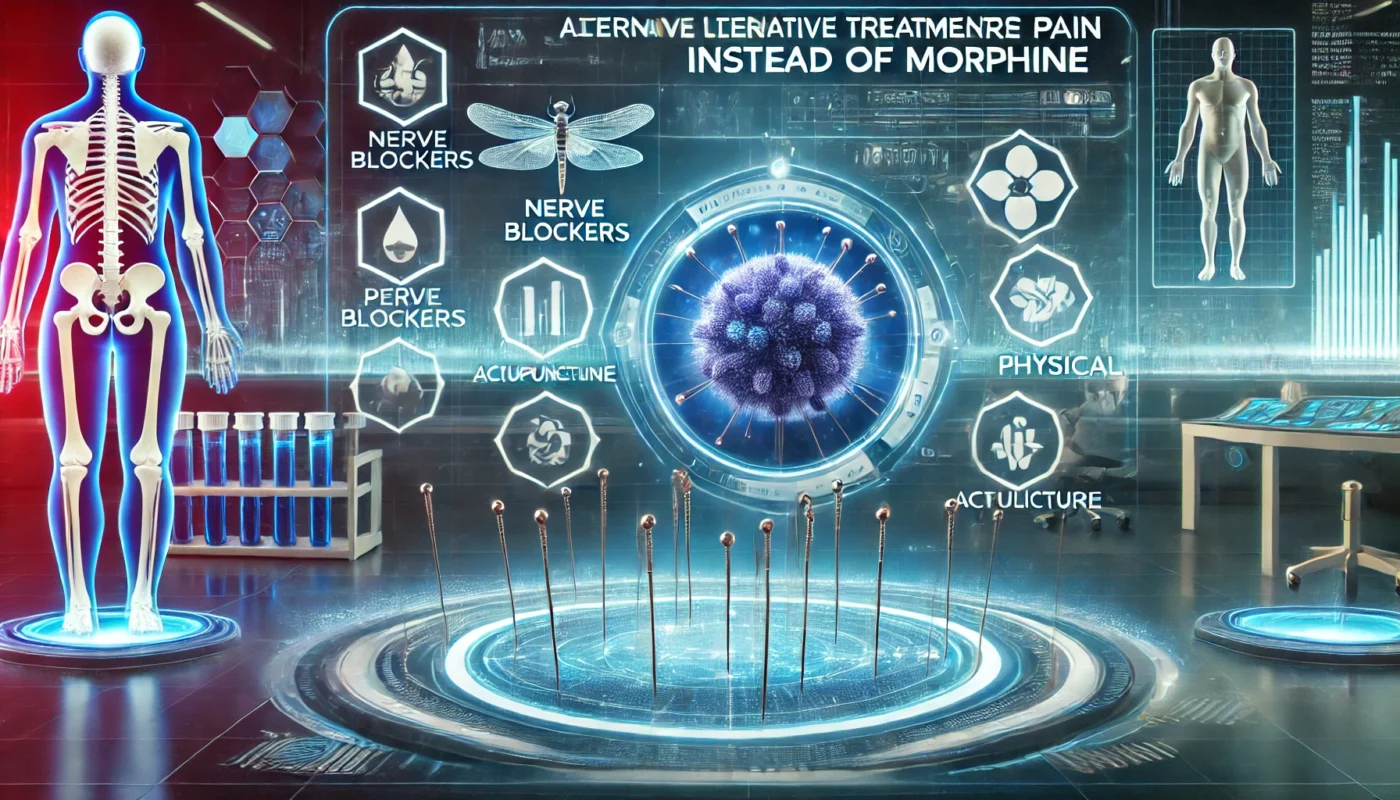In today’s evolving landscape of healthcare, understanding alternatives to morphine therapy is crucial for those seeking effective pain management strategies. As we delve into this discussion, it’s important to recognize that while morphine has long been a cornerstone in pain management, especially for severe pain, there are viable alternatives that can be both effective and less prone to side effects. Exploring these alternatives not only opens up more personalized pain management options but also addresses the growing concerns about opioid addiction and dependency.
You may also like: Understanding Long-Term Pain Relief Options
The Role of Morphine in Pain Management
Morphine is a potent opioid analgesic, primarily used for acute and chronic severe pain. It works by binding to opioid receptors in the brain and spinal cord, altering the perception of pain. However, its use is often accompanied by significant side effects, including nausea, constipation, drowsiness, and the potential for addiction. As such, exploring alternatives is not only beneficial but necessary for many individuals.
Morphine’s Mechanism of Action
Morphine’s effectiveness lies in its ability to bind to mu-opioid receptors in the central nervous system. This binding action significantly reduces the perception of pain, providing relief for patients dealing with acute or chronic pain conditions. Despite its efficacy, morphine’s mechanism also affects other bodily functions, leading to various side effects that can impact the quality of life.
Side Effects and Risks
The side effects of morphine, such as nausea and drowsiness, can be debilitating for some patients, affecting their daily activities and overall well-being. More concerning is the risk of addiction and dependency, as morphine can lead to tolerance and physical dependence with prolonged use. Understanding these risks is essential for patients and healthcare providers when considering long-term pain management strategies.
The Necessity for Alternatives
The growing awareness of opioid addiction has highlighted the importance of finding morphine alternatives. Many patients and healthcare providers are now looking for pain management options that pose fewer risks and offer a better quality of life. By exploring alternatives, patients can potentially avoid the pitfalls of opioid dependency while still achieving effective pain relief.
Exploring Morphine Substitute Options
Non-opioid medications, holistic therapies, and alternative drugs offer promising options for managing pain without relying on morphine. Understanding the various categories of alternatives can help patients and healthcare providers develop a comprehensive and personalized pain management plan.
Non-Opioid Medications
Non-opioid medications can be a first-line alternative to morphine. These include acetaminophen and nonsteroidal anti-inflammatory drugs (NSAIDs) such as ibuprofen and naproxen. These drugs work by reducing inflammation and can be effective for managing mild to moderate pain without the risk of addiction associated with opioids. It’s important to monitor their use, particularly NSAIDs, as they can lead to gastrointestinal issues with prolonged use.
Acetaminophen: A Common Choice
Acetaminophen is one of the most widely used pain relievers, often recommended for headaches, muscle aches, and minor pain. It works by inhibiting the production of prostaglandins, chemicals in the body that promote inflammation and pain. While generally safe, it is crucial to adhere to recommended dosages to prevent liver damage.
NSAIDs: Inflammation Fighters
NSAIDs, including ibuprofen and naproxen, are effective in reducing inflammation, making them suitable for conditions like arthritis and post-surgical pain. However, their long-term use can lead to gastrointestinal complications, such as ulcers or bleeding, requiring careful monitoring by healthcare providers.
Risks and Considerations
Non-opioid medications provide a safer alternative to opioids, but they are not without risks. Patients need to be aware of potential interactions with other medications and underlying health conditions. Regular consultations with healthcare providers can help manage these risks effectively.
Antidepressants and Anticonvulsants
Certain antidepressants and anticonvulsants have been found effective in managing pain. Medications such as amitriptyline, duloxetine, and gabapentin are often used for neuropathic pain, which is pain caused by damage to the nervous system. These drugs alter the way the brain perceives pain and can be an effective morphine alternative for specific types of pain.
Understanding Neuropathic Pain
Neuropathic pain arises from nerve damage and is often chronic and challenging to treat. Traditional pain relievers like morphine may not always be effective, necessitating alternative medications like antidepressants and anticonvulsants that target nerve function.
Mechanisms of Action
Antidepressants such as amitriptyline and duloxetine work by altering neurotransmitter levels in the brain, which can help modulate pain perception. Anticonvulsants like gabapentin reduce nerve excitability, providing relief from neuropathic pain. These medications offer a dual benefit of managing pain and improving mood, which can be particularly beneficial for chronic pain sufferers.
Considerations and Side Effects
While antidepressants and anticonvulsants can be effective, they come with their own set of side effects, including dizziness, fatigue, and weight gain. Patients should work closely with healthcare providers to find the right dosage and monitor any adverse effects.

Holistic and Alternative Approaches
Holistic and alternative approaches to pain management focus on treating the whole person, addressing physical, emotional, and psychological aspects of pain. These methods can complement traditional medications, providing a more comprehensive pain management strategy.
Acupuncture and Acupressure
Acupuncture and acupressure are traditional Chinese medicine techniques that involve stimulating specific points on the body to relieve pain. Research suggests that these methods can be particularly effective for chronic pain conditions. Acupuncture, in particular, has been recognized by the National Institutes of Health as a valid pain management strategy.
How Acupuncture Works
Acupuncture involves the insertion of thin needles into specific points on the body to stimulate nerves, muscles, and connective tissue. This stimulation promotes the release of natural painkillers, such as endorphins, and can improve blood flow, reducing pain and inflammation.
Acupressure: A Needle-Free Alternative
Acupressure uses finger pressure on acupuncture points to relieve pain, offering a non-invasive alternative for those uncomfortable with needles. This technique can be particularly effective for headaches, muscle tension, and stress-related pain.
Integrating Traditional Techniques
Both acupuncture and acupressure can be integrated into conventional pain management plans, offering patients a broader range of options. Consulting with trained practitioners ensures these techniques are applied safely and effectively.
Physical Therapy and Exercise
Incorporating physical therapy and regular exercise into one’s routine can significantly alleviate pain by improving strength, flexibility, and overall physical function. This approach not only helps in managing pain but also enhances recovery from injuries and surgeries. Tailored exercise programs can address specific pain issues, making them a valuable morphine substitute.
Benefits of Physical Therapy
Physical therapy focuses on restoring movement and function, often through exercises, massage, and other therapeutic techniques. It can be particularly beneficial for those recovering from surgery or injuries, as well as individuals with chronic conditions like arthritis.
Exercise as Pain Relief
Regular exercise releases endorphins, which are natural painkillers, and can improve mood, reduce stress, and enhance overall health. Low-impact activities like swimming, walking, and yoga are particularly effective for managing chronic pain and improving mobility.
Creating a Personalized Plan
Working with a physical therapist can help create a personalized exercise and therapy plan that addresses specific pain issues and goals. This tailored approach ensures exercises are safe and effective for each individual’s needs.
Herbal Remedies and Supplements
Herbal remedies and dietary supplements are increasingly popular for pain management. Substances such as turmeric, ginger, and omega-3 fatty acids have anti-inflammatory properties that can help reduce pain. However, it’s critical to consult with a healthcare provider before starting any new supplement regimen to ensure safety and efficacy.
The Power of Turmeric and Ginger
Turmeric contains curcumin, a compound with potent anti-inflammatory and antioxidant properties, making it effective for conditions like arthritis. Ginger, known for its anti-inflammatory effects, can also help alleviate muscle pain and soreness.
Omega-3 Fatty Acids
Found in fish oil, omega-3 fatty acids reduce inflammation and have been shown to help with conditions like rheumatoid arthritis and chronic pain. These supplements can be a valuable addition to a pain management regimen, promoting overall health.
Safety and Efficacy
While herbal remedies and supplements offer natural alternatives, they must be used cautiously, especially alongside other medications. Consulting with healthcare providers ensures that these supplements are safe and effective for individual health needs.
Mind-Body Techniques
Mindfulness meditation, yoga, and tai chi are powerful mind-body techniques that can reduce pain perception and improve overall well-being. These practices promote relaxation and stress reduction, which can significantly impact the experience of chronic pain. Engaging in these activities regularly can serve as an effective alternative to morphine.
Mindfulness Meditation
Mindfulness meditation involves focusing on the present moment, reducing stress and anxiety, and helping individuals manage pain more effectively. Regular practice can lead to significant improvements in pain perception and overall mental health.
The Benefits of Yoga
Yoga combines physical postures, breathing exercises, and meditation, making it a comprehensive approach to pain management. It enhances flexibility, strength, and relaxation, providing relief for chronic pain sufferers.

Tai Chi for Balance and Peace
Tai Chi, a gentle martial art, emphasizes slow, controlled movements and deep breathing. It improves balance, reduces stress, and has been shown to alleviate pain, particularly in older adults.
Morphine Alternative Drugs
In addition to non-opioid medications and holistic approaches, there are drugs specifically designed as alternatives to morphine. These include:
Tapentadol and Tramadol
Tapentadol and tramadol are opioid medications that offer pain relief with a reduced risk of addiction compared to morphine. They work on the central nervous system but also influence the reuptake of norepinephrine, making them effective for certain types of pain.
Understanding Tapentadol
Tapentadol provides a dual mechanism of action, combining opioid receptor agonism with norepinephrine reuptake inhibition. This makes it effective for both nociceptive and neuropathic pain, offering a broader range of relief.
Tramadol’s Unique Properties
Tramadol, a synthetic opioid, also inhibits the reuptake of serotonin and norepinephrine, enhancing its pain-relieving effects. It is often used for moderate to moderately severe pain, with a lower risk of dependency compared to traditional opioids.
Considerations and Side Effects
While tapentadol and tramadol have a reduced risk of addiction, they still carry potential side effects, such as dizziness and nausea. Patients should use these medications under strict medical supervision to balance efficacy and safety.
Methadone and Buprenorphine
Methadone and buprenorphine are often used in opioid replacement therapy but can also serve as pain management solutions. These drugs have a longer duration of action and a lower risk of withdrawal symptoms, making them suitable for managing chronic pain without the high risk of dependency associated with morphine.
Methadone: A Long-Lasting Option
Methadone’s long half-life makes it suitable for chronic pain management, providing sustained relief with fewer doses. It is particularly beneficial for patients requiring continuous pain control.
Buprenorphine’s Partial Agonist Action
Buprenorphine acts as a partial agonist at opioid receptors, offering pain relief with a ceiling effect that reduces the risk of misuse. Its unique properties make it an attractive option for managing chronic pain while minimizing dependency risks.
Balancing Benefits and Risks
Both methadone and buprenorphine require careful dosing and monitoring due to their potent effects and potential for interactions with other medications. Collaboration with healthcare providers is essential to optimize treatment outcomes.
Practical Pain Management Strategies
When considering alternatives to morphine, it’s essential to adopt a comprehensive approach. Here are some strategies to consider:
Consult with Healthcare Professionals
Always discuss pain management options with a healthcare provider to tailor treatments to your specific needs. A thorough evaluation can help identify the most appropriate alternatives and ensure they are safe and effective.
Combine Therapies
Utilize a combination of medications, physical therapy, and holistic approaches for a well-rounded pain management plan. This multimodal approach addresses different aspects of pain, enhancing overall relief and well-being.
Monitor and Adjust
Keep track of pain levels and treatment effectiveness, making adjustments as necessary with professional guidance. Regular assessments allow for timely modifications to the pain management plan, optimizing outcomes.
Educate Yourself
Stay informed about new pain management research and emerging alternatives to morphine. Knowledge empowers patients to make informed decisions about their health and explore innovative treatment options.

Conclusion
Understanding and exploring alternatives to morphine therapy is vital for those seeking effective and safe pain management strategies. By considering a range of options—from non-opioid medications and holistic approaches to specific morphine alternative drugs—you can find a personalized plan that alleviates pain while minimizing side effects. Remember, the journey to effective pain management is unique for everyone, and a thoughtful, informed approach can lead to significant improvements in quality of life.
Further Reading:
Study: New drug could be safer, non-addictive alternative to morphine
Opioid switching to improve pain relief and drug tolerability
Cancer Pain Relief: When to Choose Oxycodone over Morphine
herbal remedies, pain management, mindfulness meditation, yoga, tai chi, morphine alternatives, tapentadol, tramadol, methadone, buprenorphine, chronic pain, holistic approaches, non-opioid medications, pain relief, healthcare providers, patient education
Important Note: The information contained in this article is for general informational purposes only, and should not be construed as health or medical advice, nor is it intended to diagnose, prevent, treat, or cure any disease or health condition. Before embarking on any diet, fitness regimen, or program of nutritional supplementation, it is advisable to consult your healthcare professional in order to determine its safety and probable efficacy in terms of your individual state of health.
Regarding Nutritional Supplements Or Other Non-Prescription Health Products: If any nutritional supplements or other non-prescription health products are mentioned in the foregoing article, any claims or statements made about them have not been evaluated by the U.S. Food and Drug Administration, and such nutritional supplements or other health products are not intended to diagnose, treat, cure, or prevent any disease.

